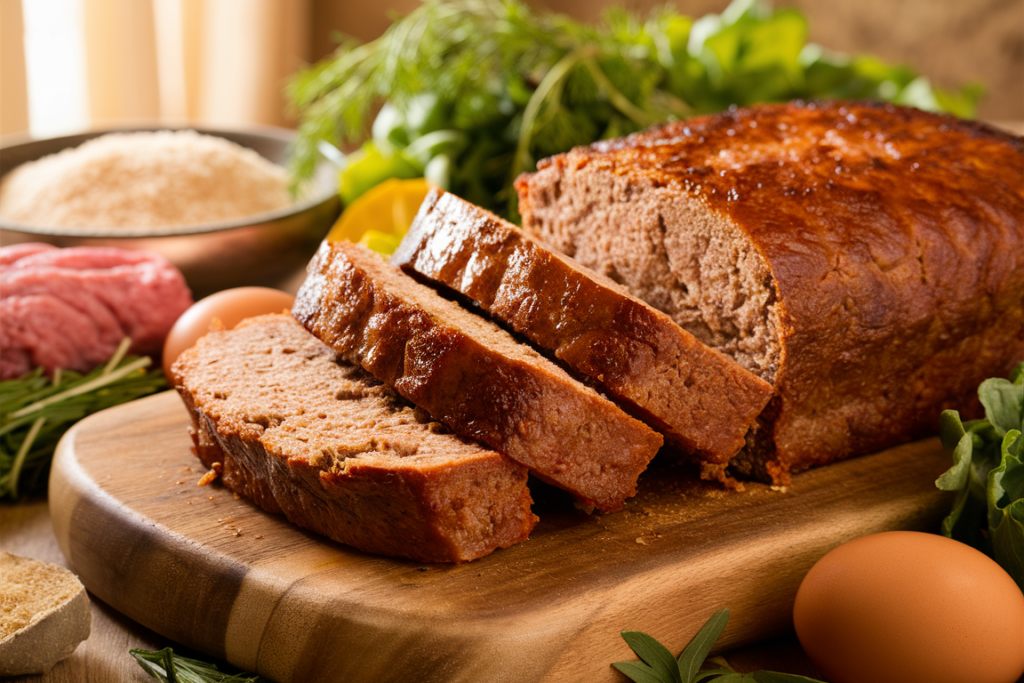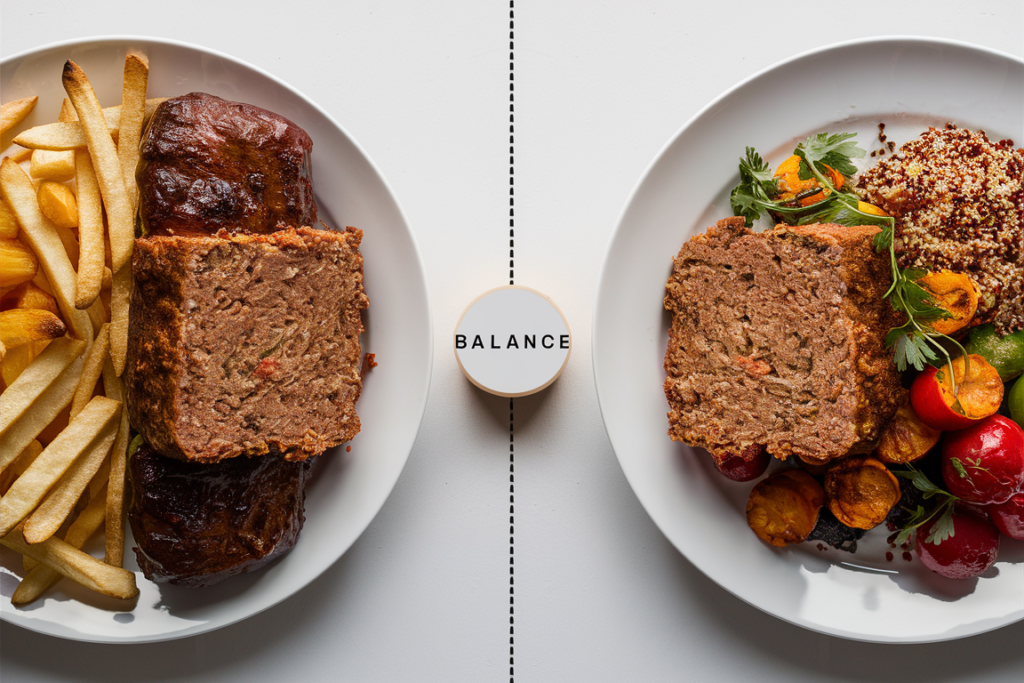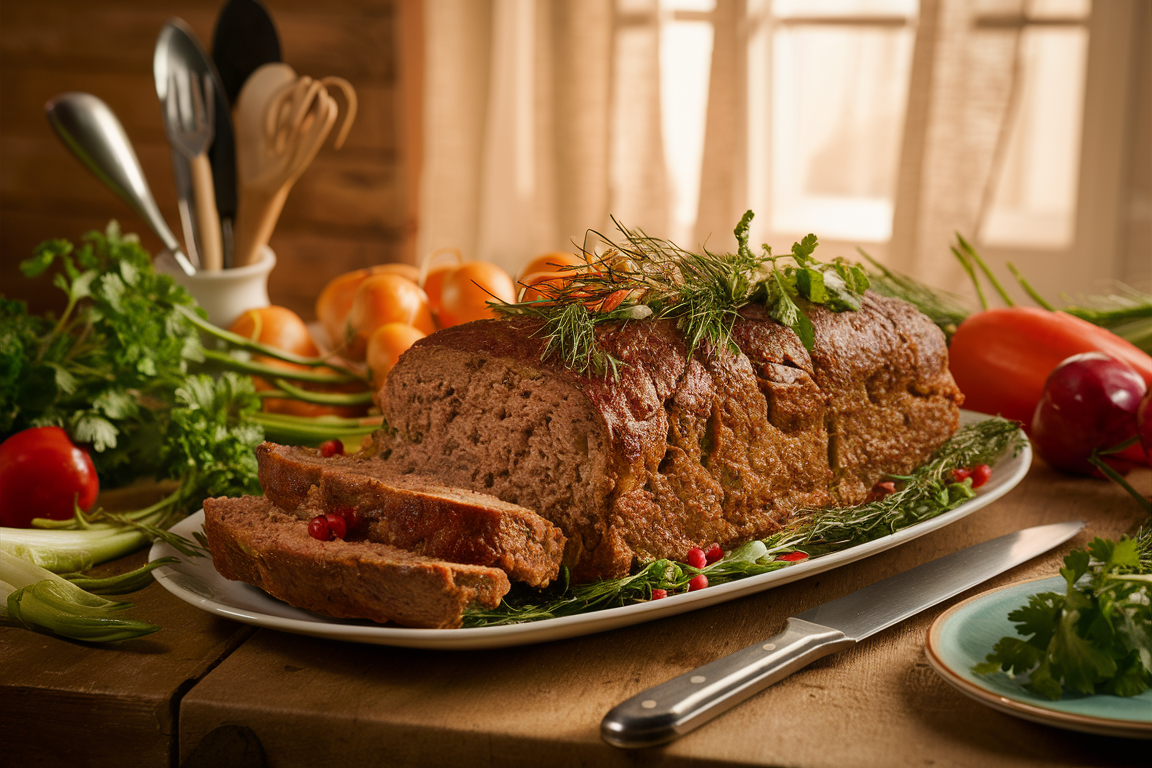Part 1: Understanding Meatloaf
What is Meatloaf?
Meatloaf is a classic comfort food enjoyed worldwide, but is meatloaf healthy? This versatile dish, made with ground meat, binders, and seasonings, has a rich history and a spot on many family dinner tables. However, its nutritional value depends largely on the ingredients and cooking methods used. By making thoughtful choices, you can enjoy meatloaf as a balanced part of your diet.

Traditional meatloaf recipes include ingredients like:
- Ground meats (beef, pork, or veal).
- Breadcrumbs or crackers as binders.
- Eggs for moisture and structure.
- Aromatics like onions, garlic, and parsley.
It is often topped with ketchup, barbecue sauce, or a glaze for added flavor. As a result, meatloaf’s adaptability has led to its inclusion in cultures worldwide, where each has added unique twists to this classic dish.
Common Ingredients in Meatloaf
The ingredients in meatloaf define its nutritional profile and health impact. Key components include:
- Ground Meat: Typically beef or pork, though turkey or chicken are also used for leaner options.
- Binders: Breadcrumbs, oats, or crackers to hold the loaf together.
- Seasonings: Salt, pepper, herbs, and spices add flavor.
- Optional Toppings: Ketchup, barbecue sauce, or gravy.
Certain add-ins, like cheese or processed meats, can increase calories and fats. Healthier versions use whole grains, fresh vegetables, and leaner proteins.
Nutritional Profile of Traditional Meatloaf
Traditional meatloaf’s nutrition varies based on ingredients and serving size. A typical slice (4 oz) contains:
- Calories: 250–300.
- Protein: 20–25 grams.
- Fat: 15–20 grams, including saturated fat.
- Carbohydrates: 10–15 grams.
- Vitamins and Minerals: Iron, zinc, and Vitamin B12 from the meat; folate and Vitamin A from vegetable add-ins.
Homemade recipes allow greater control over the nutritional content, enabling adjustments for dietary goals.
Variations of Meatloaf
Meatloaf’s versatility extends to various dietary and cultural adaptations:
- Vegetarian Meatloaf: Lentils, beans, or tofu replace meat.
- Gluten-Free Meatloaf: Substituting oats or almond flour for breadcrumbs.
- Low-Carb Meatloaf: Using almond flour or coconut flour.
- International Variations: Italian meatloaf includes mozzarella and marinara, while Swedish meatloaf features creamy sauces.
How Cooking Methods Impact Meatloaf Healthiness
Cooking methods influence the dish’s calorie and fat content:
- Baking: Retains nutrients with minimal added fats.
- Grilling: Adds a smoky flavor but can dry out the loaf.
- Steaming: Preserves moisture and avoids added fats.
- Frying: Adds significant fat and calories, making it less healthy.
Popular Add-ins and Their Effects
Adding ingredients like cheese, vegetables, or sauces can enhance flavor but impact nutrition:
- Cheese: Increases saturated fat and calories.
- Vegetables: Add fiber and nutrients, enhancing overall health.
- Sauces: May contain high sugar or sodium levels.
Comparing Meatloaf to Other Meat Dishes
How does meatloaf stack up against other popular dishes?
- Meatballs: Typically higher in fat due to frying.
- Hamburgers: Similar in content but often lack vegetables.
- Steaks: Rich in protein but lack the fiber and variety of ingredients in meatloaf.
Meatloaf offers a balance of protein, carbohydrates, and vitamins when made thoughtfully.
Meatloaf’s Place in a Balanced Diet
Including meatloaf in a balanced diet is certainly possible with mindful preparation. For instance, you can opt for lean meats, whole-grain binders, and vegetable add-ins. Furthermore, pairing it with nutrient-rich sides like roasted vegetables or a fresh salad helps create a complete and satisfying meal.
Benefits of Homemade Meatloaf
Homemade meatloaf has clear advantages over store-bought options:
- Ingredient Control: Customize ingredients to meet health goals.
- Reduced Sodium: Avoid excessive salt and preservatives.
- Eliminating Additives: Skip processed fillers and artificial flavors.
Cooking at home also allows experimentation with flavors and dietary adaptations.
Challenges with Store-Bought Meatloaf
Pre-made meatloaf may save time, but it often includes:
- High Sodium: Up to 1,000 mg per serving.
- Additives: Preservatives and artificial flavors.
- Limited Customization: Inflexibility for dietary needs.
Homemade versions provide fresher, healthier alternatives tailored to individual preferences.
Part 2: Health Factors to Consider
Is Meatloaf a High-Protein Food?
Protein is an essential nutrient, and meatloaf can be a great source depending on its composition. Traditional meatloaf made with beef or pork provides 20–25 grams of protein per serving (about 4 oz). However, not all meatloaf variations are equally high in protein:
- Ground Beef or Pork: Excellent sources of complete protein, but also higher in fat.
- Turkey or Chicken: Leaner options with similar protein content.
- Plant-Based Meatloaf: Can be protein-rich when made with lentils, chickpeas, or tofu.

High-protein diets can support muscle growth and repair, but it’s important to balance protein intake with fats and carbs for overall health.
Fat Content in Meatloaf
Fat content varies significantly based on the type of meat and add-ins used:
- Saturated Fats: Found in beef and pork, excessive intake can increase heart disease risk.
- Unsaturated Fats: Found in plant-based oils or avocado, they promote better cardiovascular health.
To reduce saturated fat in meatloaf:
- Opt for lean ground meats (90% lean beef or ground turkey).
- Avoid high-fat add-ins like processed cheese or fatty sauces.
- Bake instead of frying to minimize added oils.
Healthier Meat Choices
Choosing the right meat for your loaf can significantly impact its healthiness:
- Lean Beef: Offers robust flavor with lower fat content.
- Ground Turkey or Chicken: Lighter in calories and saturated fats, ideal for heart health.
- Plant-Based Proteins: Tofu, lentils, or tempeh offer nutrient-dense, cholesterol-free alternatives.
Experimenting with different meat or non-meat options can accommodate various dietary needs without sacrificing flavor.
The Role of Carbohydrates in Meatloaf
Carbohydrates often come from binding agents like breadcrumbs, crackers, or oats. While they help maintain structure, they also add calories and carbs:
- Breadcrumbs and Crackers: Common but refined, lacking nutrients.
- Oats: A whole-grain option with added fiber and nutrients.
Low-Carb Meatloaf Options
For those on a low-carb or keto diet, consider alternatives to traditional binders:
- Almond Flour: Low in carbs, high in healthy fats.
- Ground Flaxseed: Adds fiber and omega-3 fatty acids.
- Crushed Pork Rinds: A popular keto-friendly option.
These swaps maintain structure while reducing carbohydrate content, making meatloaf compatible with low-carb lifestyles.
Sodium Levels in Meatloaf
Seasonings and processed ingredients can make traditional meatloaf high in sodium, with some store-bought varieties containing over 1,000 mg per serving. High sodium intake is linked to hypertension and other health issues.
Tips to Reduce Sodium
- Replace table salt with herbs and spices like garlic powder, onion powder, or paprika.
- Use low-sodium broth in recipes.
- Avoid processed toppings like ketchup; opt for homemade low-sodium sauces.
Small adjustments can significantly lower sodium content without sacrificing flavor.
Are Meatloaf Add-Ins Healthy?
Add-ins like cheese, vegetables, and sauces influence the healthiness of your meatloaf:
- Cheese: Adds calcium but also saturated fats.
- Vegetables: Boost fiber, vitamins, and minerals.
- Processed Meats: Bacon or sausage add flavor but increase sodium and fat.
Boosting Nutrition with Veggie Additions
Incorporating vegetables into meatloaf enhances its nutrient profile:
- Bell Peppers and Onions: High in Vitamin C and antioxidants.
- Carrots: Add sweetness and beta-carotene.
- Spinach or Kale: Provide iron, folate, and fiber.
These options not only improve nutrition but also add moisture and flavor.
Avoiding Unhealthy Add-Ins
Steer clear of ingredients that detract from your loaf’s healthfulness:
- Processed Cheese: High in sodium and artificial additives.
- Sugary Sauces: Add unnecessary calories and sugar.
- Excessive Fats: Like butter or heavy cream.
By focusing on fresh, whole ingredients, you can enjoy a healthier version of this comfort food.
Portion Sizes and Calorie Management
Meatloaf’s calorie count depends on ingredients and portion size. A typical slice contains 250–300 calories, but oversized portions or calorie-dense add-ins can tip the balance.
Recommended Serving Sizes
- Aim for a portion of about 4–6 oz (roughly the size of your palm).
- Pair with low-calorie sides like steamed vegetables or a salad to create a balanced meal.
Tracking portion sizes and ingredient choices ensures you can enjoy meatloaf without overindulging.
Summary of Health Considerations
- Opt for lean meats or plant-based proteins to reduce saturated fat.
- Use whole-grain binders or low-carb alternatives.
- Add vegetables for fiber and nutrients.
- Limit sodium and avoid processed toppings.
Part 3: Making Healthier Meatloaf
How to Make a Healthy Meatloaf
Creating a healthy meatloaf is all about thoughtful ingredient choices and preparation techniques. A healthy version balances protein, fiber, and healthy fats while minimizing processed ingredients and sodium.
Key Steps for a Healthier Recipe:
- Choose lean proteins like turkey or chicken.
- Add whole grains or low-carb binders for structure.
- Incorporate vegetables for nutrients and moisture.
- Use low-sugar sauces or homemade toppings.
- Bake or air-fry instead of frying to reduce added fats.

Simple substitutions can transform a traditional recipe into a nutrient-dense, flavorful dish.
Lean Protein Alternatives for Meatloaf
Traditional meatloaf often uses ground beef or pork, but healthier options abound:
- Ground Turkey: Lower in fat, especially saturated fat, while high in protein.
- Ground Chicken: A lighter option that pairs well with bold seasonings.
- Plant-Based Proteins: Lentils, chickpeas, or tofu for a vegetarian twist.
- Seafood: Ground salmon or tuna offers omega-3 fatty acids and a unique flavor.
Using Whole Grains as Binders
Replacing refined binders with whole-grain alternatives boosts the fiber content of meatloaf:
- Oats: A classic option that adds texture and nutrients.
- Quinoa: High in protein and naturally gluten-free.
- Whole-Grain Breadcrumbs: Retain the traditional texture with added fiber.
These alternatives not only enhance the healthiness but also provide a satisfying texture.
Adding Nutrient-Dense Ingredients
Vegetables, herbs, and spices can elevate the nutritional profile of meatloaf while enhancing flavor:
- Vegetables: Finely chopped zucchini, carrots, or mushrooms add moisture and vitamins.
- Herbs and Spices: Parsley, thyme, and smoked paprika boost flavor without extra calories.
- Nuts or Seeds: Add a crunch and healthy fats, such as ground flaxseed or chopped walnuts.
Homemade Sauces for Meatloaf
Store-bought sauces often contain high levels of sugar and sodium. Homemade alternatives can offer the same flavor without the drawbacks:
- Low-Sugar Ketchup: Combine tomato paste, apple cider vinegar, and a touch of honey.
- Tomato-Based Sauces: Use fresh tomatoes, garlic, and herbs.
- Yogurt-Based Toppings: Mix Greek yogurt with spices for a creamy, tangy option.
These sauces allow for better control over flavor and nutrition.
Cooking Techniques for Healthier Meatloaf
How you cook meatloaf significantly impacts its healthiness:
- Baking: Retains nutrients and requires no added fats.
- Steaming: Keeps the loaf moist while preserving delicate flavors.
- Air-Frying: Adds a crisp exterior without excess oil.
- Avoid Frying: Adds unnecessary calories and saturated fats.
Using healthier cooking methods ensures your meatloaf remains delicious without compromising nutrition.
Pairing Meatloaf with Healthy Sides
A well-rounded meal includes thoughtful side dishes. Healthy accompaniments to meatloaf include:
- Salads: A mixed green or spinach salad adds fiber and freshness.
- Roasted Vegetables: Brussels sprouts, sweet potatoes, or asparagus are nutrient-rich options.
- Whole Grains: Serve with quinoa, brown rice, or barley for added fiber.
Avoiding Unhealthy Side Dishes
While traditional sides like mashed potatoes and creamy coleslaw are tempting, they can add excessive calories and fats. Instead:
- Replace mashed potatoes with cauliflower mash.
- Swap out coleslaw for a light vinegar-based slaw.
Making these adjustments creates a balanced and satisfying meal.
Meal Prep and Storage Tips for Meatloaf
Planning ahead can make meatloaf a convenient addition to a healthy diet:
- Batch Cooking: Make a large loaf and divide it into portions for the week.
- Freezing: Store slices in an airtight container or wrap them individually for easy reheating.
- Reheating: Use an oven or microwave to maintain moisture and texture.
Proper storage ensures meatloaf stays fresh and ready for quick meals.
Addressing Dietary Restrictions
Meatloaf can be adapted to meet various dietary needs:
- Gluten-Free: Use oats, almond flour, or crushed rice crackers as binders.
- Dairy-Free: Skip cheese or use plant-based alternatives.
- Vegan: Replace meat with lentils, chickpeas, or mushrooms.
These variations make meatloaf accessible to everyone, regardless of dietary restrictions.
The Environmental Impact of Meatloaf
Meat production, particularly beef, has a significant environmental footprint. Choosing sustainable ingredients can reduce your impact:
- Sustainable Meats: Look for grass-fed beef or organic poultry.
- Plant-Based Alternatives: Opt for vegetarian or vegan options to lower carbon emissions.
- Local Ingredients: Buy locally-sourced produce and proteins to support community farmers.
Incorporating these practices contributes to a healthier planet while maintaining a delicious meal.
FAQs: Is Meatloaf Healthy?
- What makes meatloaf unhealthy?
- High-fat meats, processed toppings, and excessive sodium are common culprits.
- Can meatloaf be part of a weight-loss diet?
- Yes, when made with lean proteins, whole-grain binders, and low-calorie sauces.
- What’s the healthiest meat for meatloaf?
- Ground turkey or chicken offers high protein with less fat.
- How can I reduce sodium in meatloaf?
- Use fresh herbs, low-sodium sauces, and avoid processed fillers.
- Are plant-based meatloafs healthy?
- Yes, they’re often lower in fat and cholesterol and higher in fiber.
- Can I make meatloaf gluten-free?
- Yes, substitute breadcrumbs with oats, almond flour, or rice crackers.
- What’s a good side dish for meatloaf?
- Salads, roasted vegetables, or whole grains like quinoa.
- How do I store leftover meatloaf?
- Keep it in an airtight container in the fridge for up to 4 days or freeze for longer storage.
- What vegetables can I add to meatloaf?
- Carrots, bell peppers, onions, zucchini, and spinach.
- Is it okay to eat meatloaf every day?
- In moderation, yes. Balance it with a variety of other nutrient-dense foods.

